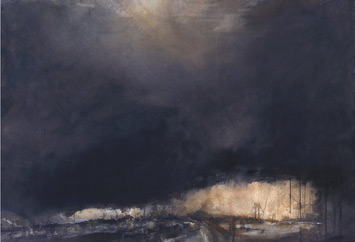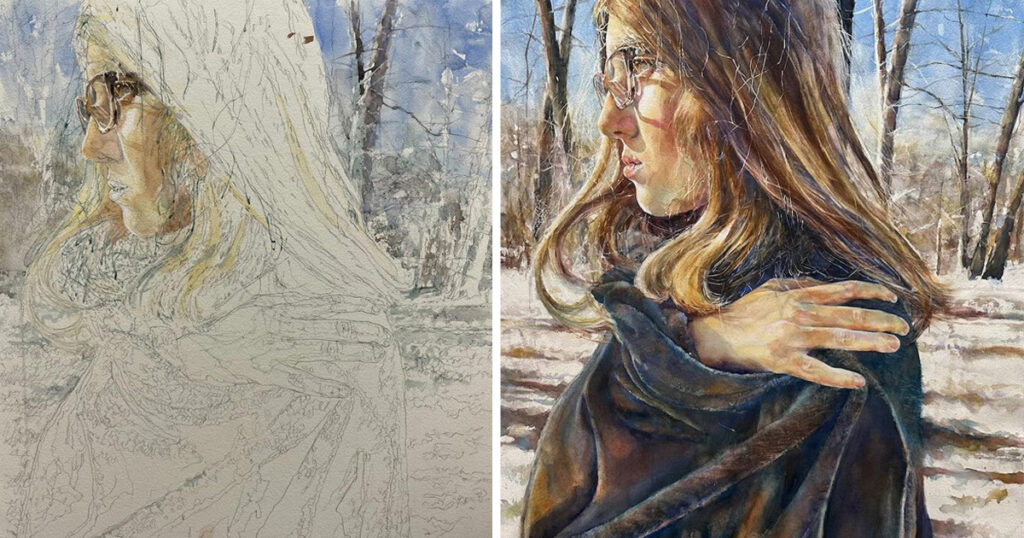Watercolor Wash Demonstration by Antonio Masi

Antonio Masi uses an interesting set of watercolor techniques, one of which is this watercolor wash technique involving glazing. He simply lets his intuition guide him as he paints on top of his glazes, following the painted layer with more glazes. Though he may use up to 30, there’s no set number of glazes he will apply. He makes sure each layer dries before he applies the next. “Glazing is my favorite part of the process because I like the control of being able to send forms or areas back into space or pull them forward,” he says.


Concept: To work out the large abstract shapes, I make three to 12 sketches in a 6×4-inch sketchbook, using a black Sharpie fine-point pen. The pen forces me to see in large, clear shapes and, working in this scale, I can usually do a sketch every five minutes. I keep sketching until I create a sketch I like.
.

Brush sketch: I approach the composition with a 2-inch watercolor brush and a very light, neutral black tint, subdividing the space as in the original concept. Then I go in with additional tints to block out the drawing. I let this completely dry.
.

Initial glazing: With an 8-inch hake brush, I apply the first transparent glaze, covering the painting except where I want to keep the white of the paper. Usually the first glazes are neutral and light to hold the picture together. Things happen in watercolor, so one must be sensitive and alert to know whether to go with them or not. At this point, I’ve applied five glazes, and you can see the watermarks (blooms).
.
Colored glazes: Next I apply different colored glazes to separate areas. The glazes in the foreground have a little body color (Chinese white) to give them weight, but I keep the sky glazes transparent. Each glaze is bone dry before the next one is applied. You can see that the watermarks are now more pronounced. I continue to keep the glazes away from the white areas I want to maintain. I take a 1-inch flat brush designed for oils and paint in the foreground to give it more solidity. When the foreground is dry, I glaze over it. This back-and-forth process goes on until I achieve the surface texture I desire.
 .
.
Rich glazes: This is the exciting part. I mix rich, juicy glazes and apply them with the 8-inch hake brush, letting each layer dry before applying the next. (In some cases I apply the glaze when the previous one is almost dry.) Also, I develop some foreground areas with Chinese white body color. Watermarks have a particular beauty; I believe some should be kept because this is the natural character of watercolor. For this painting, I apply seven additional glazes at this stage.
.

Final details and accents: This is the stage in which I pull everything together. I model the storm cloud to give it form, air and movement. I introduce light to the bridge area and echo the light at the top of the painting. All this creates a gradation from left to right, top to bottom and front to back. I pick out details and add accents, pushing the elements to capture that point when the rain seems about to pour down any minute. I check sizes, color, shapes and movement—all of which create the drama of the moment in Rainstorm over Verrazzano Bridge (watercolor, 30×40).
.
Antonio Masi was born in Italy in 1940 and immigrated to America with his family in 1947. After graduating from the School of Industrial Art (now the High School of Art and Design) in New York City, he graduated with honors from the School of Visual Arts in New York and later received his bachelor of arts degree in art history from the City University of New York. Masi is represented by the Phyllis Lucas Gallery/Old Print Center in New York City. Visit Masi’s website at www.antoniomasi.com.

Free artistsnetwork.tv preview
Click here to watch a preview of the video “Creating Luminous Watercolor Landscapes with Sterling Edwards.”
MORE RESOURCES FOR ARTISTS
• Watch art workshops on demand at ArtistsNetwork.TV
• Online seminars for fine artists
• Instantly download fine art magazines, books, videos & more
• Sign up for your Artist’s Network email newsletter & receive a FREE ebook





Have a technical question?
Contact UsJoin the Conversation!